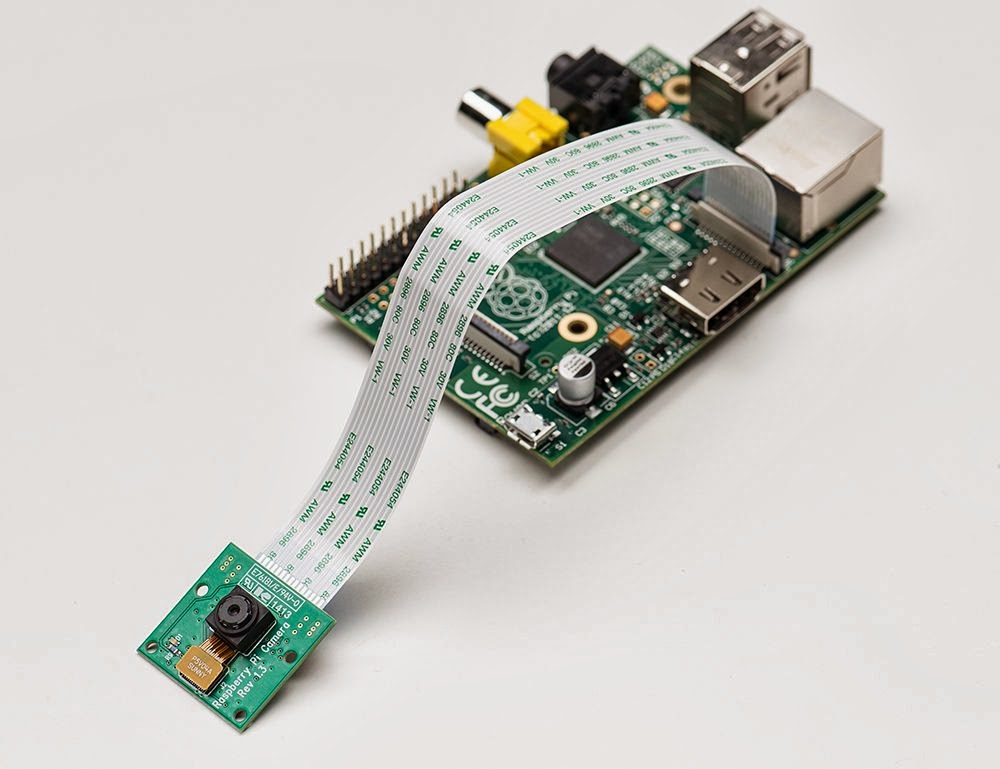Wednesday, February 19, 2014
Monday, February 10, 2014
Raspberry Pi Camera Module
The camera board is a small PCB that connects to the CSI-2 camera port on the Raspberry Pi using a short ribbon cable. It provides connectivity for a camera capable of capturing still images or video recordings. The camera connects to the Image System Pipeline (ISP) in the Raspberry Pi's SoC, where the incoming camera data is processed and eventually converted to an image or video on the SD card (or other storage).
The camera module is an Omnivision 5647. It is comparable to cameras used in mobile phones. The camera module is capable of up taking photos up to 5 Mega Pixels (5MP) (2592x1944 pixels) and can record video at resolutions up to 1080p30 (1920x1080x30 fps). The camera module supports raw capturing (Bayer data direct from the sensor) or encoding as JPEG, PNG, GIF and BMP, uncompressed YUV, or uncompressed RGB photos. It can record video as H.264 baseline, main or high profile formats.
There are three command line applications provided for stills, video, and stills output uncompressed. These applications provide the typical features you might find on a compact cameras. eg., Set image size, compression quality, exposure mode, ISO.
The camera board requires 250mA to operate. Make sure you ensure your power supply can provide enough power for the camera module as well as the Raspberry Pi, and any peripherals directly attached to the Raspberry Pi.
Raspberry Pi - Introduction
The Problem that needs solving
The original idea in 2006 was a response to the gradual drop in computing skills seen in students applying for computing degrees at Cambridge. Everyone knew how to use Microsoft Word, Powerpoint, Excel, Access; they didn't know much about coding, though or what actually happened inside the machine. Considering Computer Science isn't about giving flashy presentations, this was a big deal.
Those familiar with schools in the 1980s will know they were full of BBC Micro computers and everyone learnt how to write programs in BASIC, PASCAL or LOGO. Computer games back then ran on computers that were practically built for coding, and plenty of amateur enthusiasts now work in the computer science industry. Sadly, as computers have become more complicated, school lessons have changed to train students in simple computer usage, without understanding what goes on underneath.
The Solution
Thus, the solution: make a cheap but very capable computer that can be used in classrooms, that can be replaced easily if broken, and that lets you play with computer code whether at school or at home. Make it so plugs into the TV at home, like computer used to do. Ship it with a web browser so that the students have access to no end of programming manuals via the Internet. Make it so it can be expanded with a chip to let it control the robots. And it wouldn't hurt if it could handle HD video - which it can. There are, of course, similar efforts out there such as the BeagleBoard and the Pandora handheld console, but they fall down either on their expense, or their reliance on teaching trickier codes like C++ rather than the easy-to-learn Python.
The Raspberry Pi
The Raspberry Pi (or 'Raspi') is a computer about the size of a credit card, designed to cost only $25 for the cheapest model. This includes a 700MHz processor, an HD capable graphics setup, and at least 128MB of memory; there's also a memory card slot, audio/video outputs to connect to your TV, and a USB port for your keyboard, mouse and so forth. With all that, the computer uses less power than a lightbulb. It was developed by a group of Computer Science lecturers from Cambridge University, one of whom (Eben Upton) now works for computer chip designers Broadcom.
In less than two years the Raspberry Pi has sold more than 1 million units and become widely used and adored among hackers and embedded professionals alike. It began in 2006 as a modest idea to provide a low cost educational computer for students to tinker with. Now the $25 Linux-based Credit card sized computer is the basis for all kinds from Robotics to LED blink.
Sunday, February 9, 2014
Eben Upton Explaining Raspberry Pi at TEDEX
Eben Upton is the founder of the Raspberry Pi Foundation, which is developing a $25 microcomputer with the goal of putting programmable hardware in the hands of every child in the UK. Eben is responsible for the overall software and hardware architecture of the Raspberry Pi device.
Subscribe to:
Comments (Atom)

